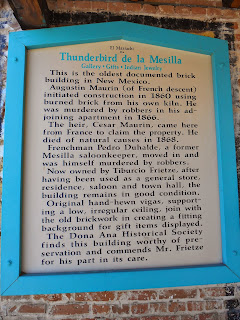Thursday – April 23, 2015
Mesilla, New Mexico
We spent Wednesday and Thursday touring historic Mesilla, New Mexico. Mesilla is a tiny town sitting next to the much larger town of Las Cruces, New Mexico. Mesilla has become the ‘little secret’ of Las Cruces.
On Wednesday we had lunch at La Posta de Mesilla, famous for Mexican food and steaks since 1939. The food, service and atmosphere were excellent. This building is the original La Posta (in Spanish, for centuries past, Las Postas were Inns built for the King’s rest and were stationed at intervals along important travel routes). For more than two centuries, the adobe walls of this building have withstood the attack of elements and man. They have sheltered such personalities as Billy the Kid, Kit Carson, General Douglas MacArthur and Pancho Villa.
After lunch we treated ourselves to some chocolate covered pecans at the New Mexico Pecan Co. shop. We also purchased a jar of Ol’ Gringo green chile. Ol' Gringo Chile Company is located in Las Cruces, New Mexico-near the heart of famous New Mexico chile country. In August and September of every year you can smell fresh chile roasting outside grocery stores and in back yards. As far as the eye can see, fields of green chile are turning red.
On Thursday we had lunch at the Peppers Café, located inside the Double Eagle Restaurant. This restaurant is an officially Recognized Site of the New Mexico Green Chile Cheeseburger Culinary Trail. Their green chile cheeseburger has been listed as one of the best in New Mexico, – with locally raised green chile their specialty! In our quest to sample the best green chile cheeseburgers New Mexico has to offer, Peppers Café definitely lives up to its reputation. Their green chile cheeseburgers were outstanding!
History of Mesilla
Mesilla ("Little Tableland") is the best-known and most visited historical
community in Southern New Mexico. Since its' beginning, around 1848, Mesilla has
had a major influence on the economic, cultural, historical, and political life
of the Mesilla Valley. From the Gadsden Purchase, to the Civil War, to the
Butterfield Stage Coach Trail, to the trial of Billy the Kid, to being a lively
social center in the 1880s--Mesilla has been a prominent part of the rich
history of the Southwest.
Today, many of Mesilla's population of nearly 2,200 residents are direct descendents of Mesilla's early settlers. Mesilla has a rich and diverse heritage with the integration of Indian, Spanish, Mexican, and Anglo-American cultures. Perhaps the greatest import of the past history is the physical character of the community itself. The traditional adobe structures and architectural features modified through time because of style and technology still remain as a reminder of the long and significant history of the town.
The village of Mesilla was incorporated in 1848, after the Treaty of Guadalupe Hidalgo moved the U.S.-Mexico border south of the village of Doña Ana, placing it in the United States. A small group of citizens, unhappy at being part of the United States, decided to move south of the border. They settled in Mesilla at this time.
By 1850, Mesilla was an established colony. By this time, its people were under constant threat of attack from the Apache. By 1851, the attacks caused the United States to take action to protect its people just to the north of the border, in the Mesilla Valley. They did this by creating Fort Fillmore. As a result of the fort, the United States declared the Mesilla Valley region part of the United States. Mexico also claimed this strip of land, causing it to become known as "No Mans Land." This boundary dispute, which was officially caused by a map error, was resolved in 1853, with the Gadsden Purchase. Mesilla became a part of the United States, as well as the southern part of New Mexico and Arizona.
Two battles were fought at or in the town during the Civil War. Mesilla served as the capital of the Confederate Territory of Arizona in 1861-1862 and was known as the "hub", or main city for the entire region. Recaptured by the Volunteers of the California Column, it then became the headquarters of the Military District of Arizona until 1864.
During the "Wild West" era, Mesilla was known for its cantinas and festivals. The area attracted such figures as Billy the Kid, Pat Garrett and Pancho Villa. The village was also the crossroads of two major stagecoach lines, Butterfield Stagecoach and the Santa Fe Trail. The village of Mesilla was the most important city of the region until 1881.
In 1881, the Santa Fe Railway was ready to build through the Gadsden Purchase region of the country. Mesilla was naturally seen as the city the railroad would run through. However, the people of Mesilla asked for too much money for the land rights, and a land owner in nearby Las Cruces, New Mexico, a much smaller village than Mesilla, stepped in and offered free land. The city of Mesilla has not grown much since, and Las Cruces has grown to a population of an estimated 95,000 people (2010) and is currently the second largest city in New Mexico.
La Mesilla Historic District, which includes Mesilla Plaza, was declared a National Historic Landmark in 1961. The Fountain Theatre, except for 12 years, has been in operation since the early 1900s.
Oldest Documented Brick Building in New Mexico (1860)
Tomorrow another adventure begins.






























No comments:
Post a Comment